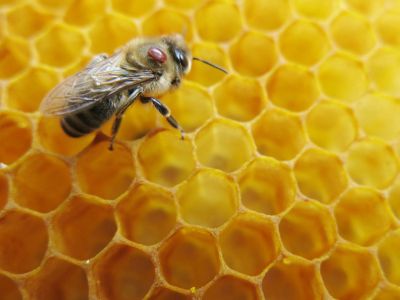What are Bee Mites?
Mites are arachnids related to spiders. They can be pests because they bite people, but they can also be destructive to other species. There are two types of mites in North America that attack and harm individual bees and colonies:
Tracheal mite (Acarapis woodii): American beekeepers first saw these mites in colonies in the 1990s. They are microscopic and live in the trachea. Young bees are most susceptible. The mites can block their breathing and lead to death. They cause the most damage in colder climates where bees huddle together in winter, spreading the infestation. Many North American bee stock are now resistant to these mites.
Varroa mite (Varroa destructor): You can see a varroa mite on a bee. It resembles a tick, about 1.5 millimeter in size. These mites pierce the bees from the outside and feed. They hijack the lifecycle of the honeybee colony to reproduce on the same cycle. Affected colonies may seem healthy and productive but then die off in fall or winter.
Honeybee Mite Damage
While most strains of cultivated honeybees in North America are now resistant to tracheal mites, varroa mites can cause significant damage. They spread two important viral infections in bees, among others, deformed wing virus and acute bee paralysis virus. Either of these can lead to colony collapse. You may have the viruses in your colony if you notice that larvae are dying prematurely.
Mite Control for Honeybees
First, it’s important to understand what you have, which type of mite and if it really is a mite causing problems in the hive. Contact your local extension office to find out how to test for mites. Start a colony with resistant bees, if possible. Tracheal mite-resistant stock is more common, but in recent years scientists have also developed honeybees with resistance to varroa. There are also some control methods for tracheal mites:
Place menthol pellets in the hive to kill mites. This is most effective in warm weather.Use light syrup in the hive to encourage brood production.Introduce a mite-resistant queen.
For varroa mites, try these strategies:
Place a varroa mat under the hive. This is a sticky mat covered by a screen. The bees cannot touch the mat because of the screen, but mites fall through and are collected.Use biopesticides designed to manage varroa. These use essential oils or formic acid.Try synthetic pesticides like Apistan, Apivar, and Checkmite.
Do not try any other pesticides with your colony, as they can kill the bees. If you are unsure what to do to help your hives, contact your extension office for advice.
